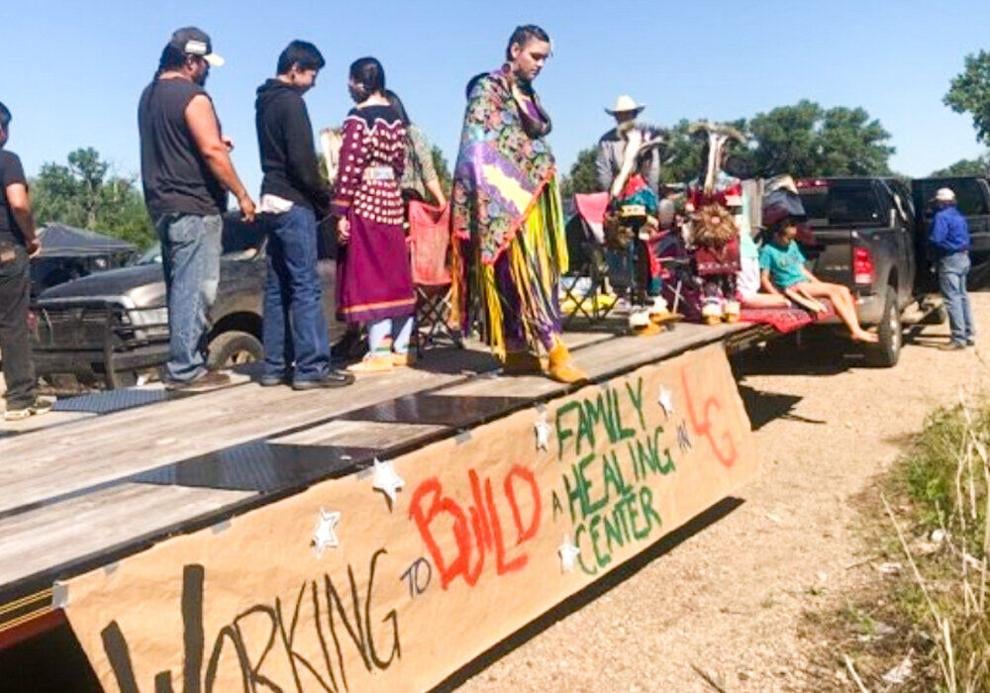
This 2019 photo shows Lodge Grass residents campaigning for the creation of a family healing center.
Image courtesy of Mountain Shadow Association
Lodge Grass non-profit gets funding for family healing center: read

This 2019 photo shows Lodge Grass residents campaigning for the creation of a family healing center.
Image courtesy of Mountain Shadow AssociationA non-profit on the Crow Reservation just got a boon to its efforts to keep families in Lodge Grass intact and in good health.
The Mountain Shadow Association, based in Lodge Grass, received a six-figure grant toward the creation of a family healing center with the ambition of preventing trauma or addiction from leading to children being pulled from their homes and potentially off the reservation.
“What we want is support for the whole family unit,” said Megkian Doyle, executive director for the Mountain Shadow Association. “What we want is for kids and their parents to be engaged in services for emotional and social support.”
With a population of roughly 450, Lodge Grass is unique in being the only incorporated town on the reservation. Located about 80 miles southeast of Billings, the Lodge Grass District of the Crow Reservation is home for about 2,000 people. Over 90% of its population is Native American.
Doyle, who earned a doctorate in education from Montana State University, came to Lodge Grass to teach at Lodge Grass High School. She met her husband in town, a Crow man, and the two have since had five children. After teaching for three years, she said, seeing the conditions in Lodge Grass inspired her to find a position to improve life for its residents.
She moved to Bozeman with her family, where she and her husband got masters and doctorate degrees. During that time, Doyle stayed in touch with her former students. Talks with them evolved into discussions on how best to assist a town in which nearly half of the population lives beneath the poverty line.
“I asked them, ‘If there’s anything you could do besides pray, what would you do?’” she said.
In 2017, a coalition of Lodge Grass residents banded together to apply for a grant from the Raising Places Robert Wood Johnson Foundation, which gave them the resources to exhaustively study the factors contributing to the economic and health disparities in town.
“It meant bringing in everyone, including people who are not normally asked for their opinion, like children,” Doyle said.
The results were stark. Nearly 90% of newborns in Lodge Grass are born to single mothers, roughly one in five of whom are teenagers, and about half of all children in Lodge Grass are raised by their grandparents.
As recently as 2020, according to federal data, about 9% of the children in Montana were Native American. However, they made up 35% of the children in the state’s foster care system.
Earlier this year, Gov. Greg Gianforte signed into law the Montana Indian Child Welfare Act, which gave Native American families legal preference in foster and adopting Indigenous children in the state. The Montana legislation was modeled after the federal Indian Child Welfare Act of 1978, which was passed in response to Indigenous children being adopted and fostered outside of their respective tribes only to face physical and emotional abuse.
Nationwide, Indigenous children are four times more likely to enter the foster care system than white children, according to the National Indian Child Welfare Association. Among the leading causes for Native American kids entering the foster care system in the respective states were allegations of neglect and substance abuse on the part of their parents.
Separating a child from their family, Doyle said, can have long-term physiological effects, despite a child entering an ideal foster home. Per research published by the National Institute of Health, children separated from their families at an early age experienced higher rates of anxiety and depression and engaged in unhealthy coping behaviors like smoking and alcohol abuse.
“We can have a great foster care system — we don’t — but even if we did it can still cause damage just by pulling a kid away from their home and their parents,” Doyle said.
From that Lodge Grass coalition that applied from the Raising Places grant came the Mountain Shadow Association. Coming to the aid of children often means coming to the aid of parents, Doyle said. The non-profit currently assists parents in enrolling in treatment for addiction, but programs that allow them to bring their children along are a 19-hour drive away.
The solution members of Mountain Shadow reached was the construction of a facility in Lodge Grass where whole families can get treatment without any separation. It’s called Káale’s Village; “káale” is the Crow word for grandmother.
“We wanted to interrupt family separation on the spot before they would lose their kids,” Doyle said. “But we wanted to do it, obviously, in a safe and healthy way.”
Mountain Shadow has the land for Káale’s Village, 13 acres in Lodge Grass. Now, thanks to a $750,000 grant from the Arthur M. Blank Family Foundation, the non-profit can start designing it. The center will be a single location for counseling and housing for two families. That space, Doyle said will be for children who need to be removed from their home in Lodge Grass to stay.
“We want people to become functional in their own ecosystem,” Doyle said.
Once the architectural designs are completed, Doyle said, the non-profit hopes to see Káale’s Village opened in two years.























No comments:
Post a Comment
Please: Share your reaction, your thoughts, and your opinions. Be passionate, be unapologetic. Offensive remarks will not be published. We are getting more and more spam. Comments will be monitored.
Use the comment form at the bottom of this website which is private and sent direct to Trace.